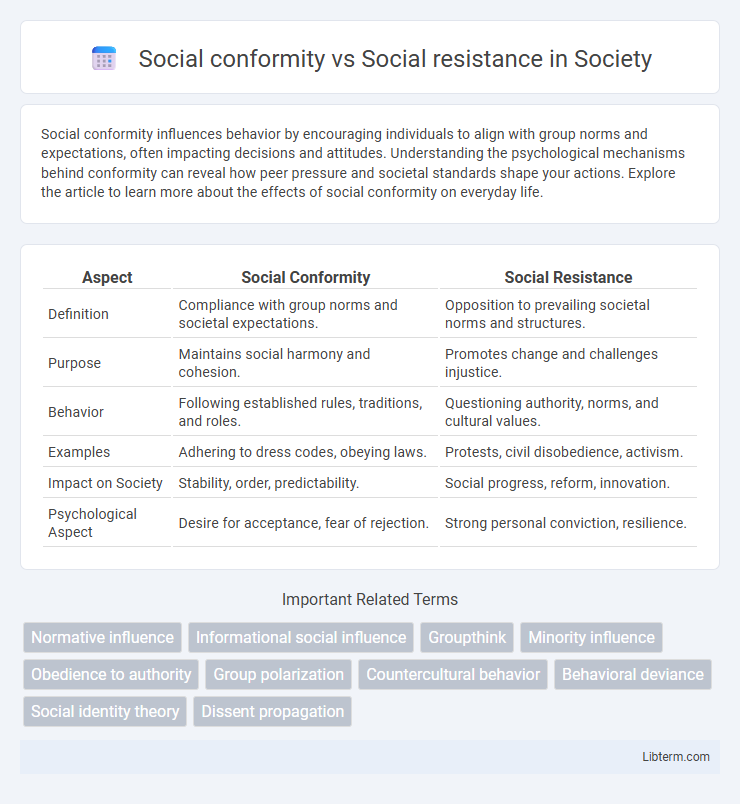Social conformity influences behavior by encouraging individuals to align with group norms and expectations, often impacting decisions and attitudes. Understanding the psychological mechanisms behind conformity can reveal how peer pressure and societal standards shape your actions. Explore the article to learn more about the effects of social conformity on everyday life.
Table of Comparison
| Aspect | Social Conformity | Social Resistance |
|---|---|---|
| Definition | Compliance with group norms and societal expectations. | Opposition to prevailing societal norms and structures. |
| Purpose | Maintains social harmony and cohesion. | Promotes change and challenges injustice. |
| Behavior | Following established rules, traditions, and roles. | Questioning authority, norms, and cultural values. |
| Examples | Adhering to dress codes, obeying laws. | Protests, civil disobedience, activism. |
| Impact on Society | Stability, order, predictability. | Social progress, reform, innovation. |
| Psychological Aspect | Desire for acceptance, fear of rejection. | Strong personal conviction, resilience. |
Understanding Social Conformity
Social conformity involves individuals adjusting their behaviors, attitudes, or beliefs to align with group norms, driven by the human need for acceptance and belonging. This phenomenon is studied extensively in social psychology, highlighting mechanisms such as normative influence, where people conform to avoid social rejection, and informational influence, where conformity arises from the desire to be correct. Understanding social conformity reveals its impact on decision-making processes, group dynamics, and the maintenance of societal order.
The Psychology Behind Social Resistance
Social resistance emerges from cognitive dissonance when individuals face pressure to conform against their personal beliefs or values. Psychological mechanisms such as self-identity maintenance, moral conviction, and social identity theory drive people to oppose majority influence. Studies in social psychology highlight that resistance is often strengthened by perceived threats to autonomy and group norms supporting dissent.
Historical Examples of Conformity and Resistance
Historical examples of social conformity include the widespread compliance with the Nazi regime in Germany during the 1930s and 1940s, where propaganda and social pressure led many citizens to support or tolerate authoritarian policies. In contrast, social resistance is exemplified by the Civil Rights Movement in the United States during the 1950s and 1960s, where activists challenged racial segregation and systemic discrimination through protests and civil disobedience. The contrasting dynamics of conformity and resistance reveal how social norms and power structures influence collective behavior across different historical contexts.
Factors Influencing Social Conformity
Social conformity is influenced by factors such as group size, unanimity, cohesion, status, and cultural norms, which enhance the pressure to align behaviors or beliefs with a group. The presence of an authoritarian figure or majority opinion increases conformity by triggering a desire for acceptance and fear of rejection. Cognitive factors, including informational influence where individuals assume the group is correct, also play a crucial role in driving social conformity.
Drivers of Social Resistance in Groups
Drivers of social resistance in groups include strong group identity, perceived injustice, and collective efficacy. When group members share common values and beliefs, they are more likely to resist dominant social norms to protect their collective interests. Perceived threats to autonomy or fairness intensify resistance by motivating coordinated opposition and reinforcing solidarity within the group.
Positive and Negative Effects of Conformity
Social conformity fosters group cohesion and promotes social harmony by encouraging individuals to adhere to shared norms and values, which can lead to increased cooperation and stability in communities. However, excessive conformity may suppress individuality, stifle creativity, and perpetuate harmful behaviors or unjust social practices, limiting critical thinking and social progress. Balancing conformity with social resistance is essential to promote positive social change while maintaining social order.
The Risks and Rewards of Social Resistance
Social resistance involves challenging prevailing norms, which presents risks such as social rejection, loss of status, or economic consequences. However, it offers rewards like fostering social change, innovation, and the affirmation of personal or group identity. Understanding these dynamics is essential for navigating the balance between conformity and resistance in societal contexts.
Social Conformity in Modern Society
Social conformity in modern society manifests through widespread adherence to social norms, driven by the desire for acceptance and fear of social exclusion. Digital platforms amplify conformity by shaping collective opinions and behaviors through algorithms that promote popular content, reinforcing group norms. This phenomenon impacts decision-making processes, often leading individuals to align with majority views even when they conflict with personal beliefs.
Case Studies: Conformists vs. Resisters
Case studies contrasting social conformity and social resistance reveal that conformists often align with group norms to gain social acceptance and reduce conflict, exemplified by the Asch conformity experiments where participants yielded to majority opinion despite contradicting evidence. In contrast, resisters like civil rights activists challenge prevailing social norms to promote change, as demonstrated by Rosa Parks' refusal to give up her bus seat, igniting significant social movements. These case studies highlight the psychological and social dynamics influencing decisions to conform or resist within societal contexts.
Building a Balanced Approach to Social Influence
Balancing social conformity and social resistance involves recognizing the benefits of adapting to group norms while maintaining personal values and critical thinking. Effective social influence fosters collaboration and innovation by encouraging individuals to conform when it promotes social harmony and resist when it challenges unjust or harmful practices. Developing this equilibrium enhances both individual autonomy and collective well-being in diverse social environments.
Social conformity Infographic

 libterm.com
libterm.com